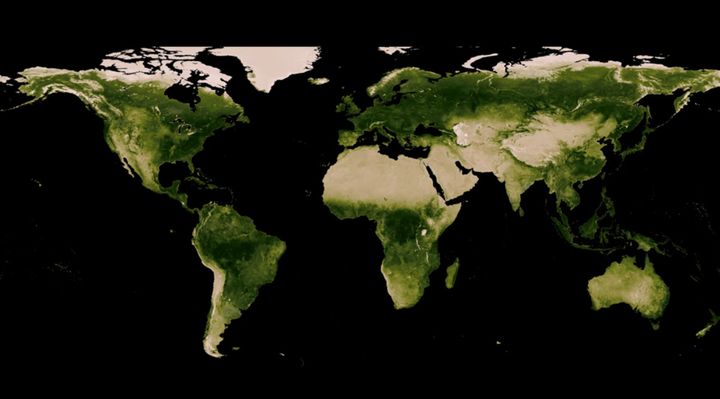If you are someone who considers climate change to be terrifying, this article will give you reason for hope. Knowing that humans have never before lived on the planet when CO2 exceeded 300 parts per million (PPM) and seeing the statistics on glacial melting while knowing what this data implies can be quite scary. When we change our understanding of the problem it will have a huge impact on how we approach that problem. Though the solutions are greater than I can fit into this short blog you may very well go from fear of global warming to excitement for the future before we are done.

Visit here for an interactive map
Paul Hawken is one of the first people to postulate that climate change is a great invitation to innovate as well as a pathway to creativity, compassion, and human ingenuity. Physicist-Entrepreneur, Peter Fiekowsky and the Healthy Climate Alliance takes this one step further by offering us a path to 300 PPM by 2050. The journey ahead of us will be a story of turning stumbling blocks into stepping stones as humanity is on the verge of a monumental evolutionary leap.
“We see global warming not as an inevitability, but as an invitation to build, innovate and effect change; a pathway that awakens creativity, compassion, and genius. This is not a liberal agenda, this is not a conservative agenda — this is a human agenda.” ― Paul Hawken, Author of Drawdown, the Most Comprehensive Plan ever Proposed to Reverse Global Warming
We know that the oil industry and lobbyists have a powerful grip on governmental policies world-wide. We recognize that they are interested in selling oil because that is their business and therefore they have a fiduciary duty to their stockholders to counter any legislation that will harm their stock prices. We also know that many people are in denial of climate science because it is either too confusing, scary, or overwhelming and they don’t feel empowered to do anything about it. Then there are those who believe that God is in control of our climate and it is not our responsibility to fix it.
The Healthy Climate Alliance is built upon the idea that it is our responsibility and our moral obligation to leave our children and future generations a climate as healthy as that which our grandparents gave us. The climate goal that embodies this message is returning to 300 parts per million (ppm) CO2 by 2050. ― Healthy Climate Alliance
The best thing about these proposed solutions is that they can easily gain bi-partisan support and be embraced by all of the nay-sayers listed above. The process of making peace with our “enemies” in the climate battle will be as beautiful as restoring our planet. Truth is that there are no “enemies” but merely our fellow human beings with their own beliefs and responsibilities. As we change our understanding of the problem and begin implementing the solutions the divisions between us will also begin to dissolve.
Encourage our climate leadership―the UN, religious organizations, NGOs, scientists, and Congress to commit to giving our children the same climate our grandparents gave us, 300 ppm by 2050. ― Healthy Climate Alliance
Engineering vs. Science. During my chat with Peter, he told a great story about the importance of recognizing the difference between these two disciplines. Scientists are not allowed to “put their finger on the scale”, their work is based on being objective, observing and making predictions based on peer-reviewed research. Fiekowsky’s example is that of an asteroid hurtling towards the planet. The scientists can predict for us how fast it is going, where it is likely to hit and an estimate of how many people it might kill. However, they can not tell us how to blow up the asteroid so that it doesn’t collide with our planet because that would be putting a finger on the scale and intentionally changing the outcome of the experiment. Changing the outcome however is exactly the job of an engineer!
The scientist and the engineer each have important roles but we can’t ask one to do the work of the other. That’s why Fiekowsky realized that we need to propose the question to engineers with a specific deadline and target number. He asked, “Can we get to 300 PPM by 2050, and if so, how might we do it?” The resounding answer is YES! This is where the 300 by 2050 initiative was born.
The Paris Climate Agreement set a goal of 450 PPM by 2050 but 350 PPM has already been the accepted tipping point. Even if we are to stop all fossil fuel usage in 10 years, which is highly unlikely, we are projected to be at around 430 PPM by 2050. The current number is 407 PPM meanwhile Paul Hawken already has models that take into account other atmospheric particulates that contribute to global warming which make that number much higher. Bottom line is that the standard notion of reducing carbon emissions, though still important, is not enough and we will need to literally remove many tons of carbon from our atmosphere.
The Paris agreement calls for an 80% reduction in emissions by 2050 in order to stay below two degrees warming. However, the IPCC and prominent climate scientists have claimed that two degrees warming will still subject future generations to irreparable harm. In short, the goals set forth in the Paris Agreement are insufficient. ― Healthy Climate Alliance
On Land and Sea... Carbon Dioxide Removal (CDR) technologies are central to climate restoration. Soil and trees naturally sequester CO2 yet three-quarters of our planet is covered with oceans, so we must look at land-based and ocean-based technologies. Land-based methods use “direct air capture” (DAC), which concentrates CO2 from the atmosphere for sequestration or re-use as a renewable building material. Ocean-based methods help to increase fish and seaweed production, while simultaneously sequestering carbon as detritus falls towards the ocean floor.
Making Concrete out of Thin Air and Adding Fish to the Sea! Many CDR methods yield secondary products like fish, seaweed in the ocean, and concrete aggregate on the land. These byproducts can then be sold thus allowing these methods to be incentivized for businesses without needing any public subsidy. This makes the cost inconsequential and potentially opens the gates for profits to be made while restoring our planet to a healthy climate.
The Icing on Top. Those who have been studying climate change are probably wondering about methane and the polar ice-caps melting at an enormous rate. It is true that in addition to removing CO2, we will need to help the climate cool. Luckily the engineers have multiple ideas on how to achieve this as well. A simple one is to pump sea water onto sea ice during the winter. This will allow the ice to grow faster in the winter than it will melt in the summer and help our planet cool down.
A Few Hoops to Jump Through. Currently the Intergovernmental Panel on Climate Change (IPCC) is going through the steps they need to in order to add climate restoration to the climate goals. It will take some time to add climate restoration language, but it could very well happen in 2018. Partnering organizations are compiling the needed research and development as well as curating the needed peer-reviewed papers. Economists, and politicians on both sides of the aisle will have a green light to back the proposal in a few short months!
Climate Change is Catalyzing Human Evolution. We are being called to change the way we identify ourselves as a species in order to address the current situation. Most of us don’t say to ourselves “I’m going to add CO2 and contribute to global warming” every time we get in our car and drive to the store. We are mostly unconscious of our impact, and yet we are too willing to accept that it isn’t our responsibility to remove CO2 from the atmosphere. We are no longer helpless passengers on spaceship earth, and we can’t afford to see ourselves that way. We are an apex species with the power to destroy or restore our climate. We are in the cockpit and must take full responsibility and empower ourselves to take conscious steps towards creating a healthy climate for future generations as well as all other species. This is key initiative of the Future of Humanity by presenting solutions to help reach Sustainable Development Goals.
This journey will invite and require unprecedented cooperation between nations. It will allow a shared sense of “we are all in this together”, which brings unity and a sense of our human roles as stewards of this beautiful planet. This doesn’t mean we sit back and let the engineers take care of the problem, we each need to be pro-active for our communities. Every little bit of lifestyle change like reducing your own carbon footprint, planting trees, or supporting others to plant trees (see Tree Sisters), while continuing to pressure your representatives to embrace climate solutions is helpful. All hands on deck for what will be one of the most exciting and transformational times to be alive on Planet Earth!
